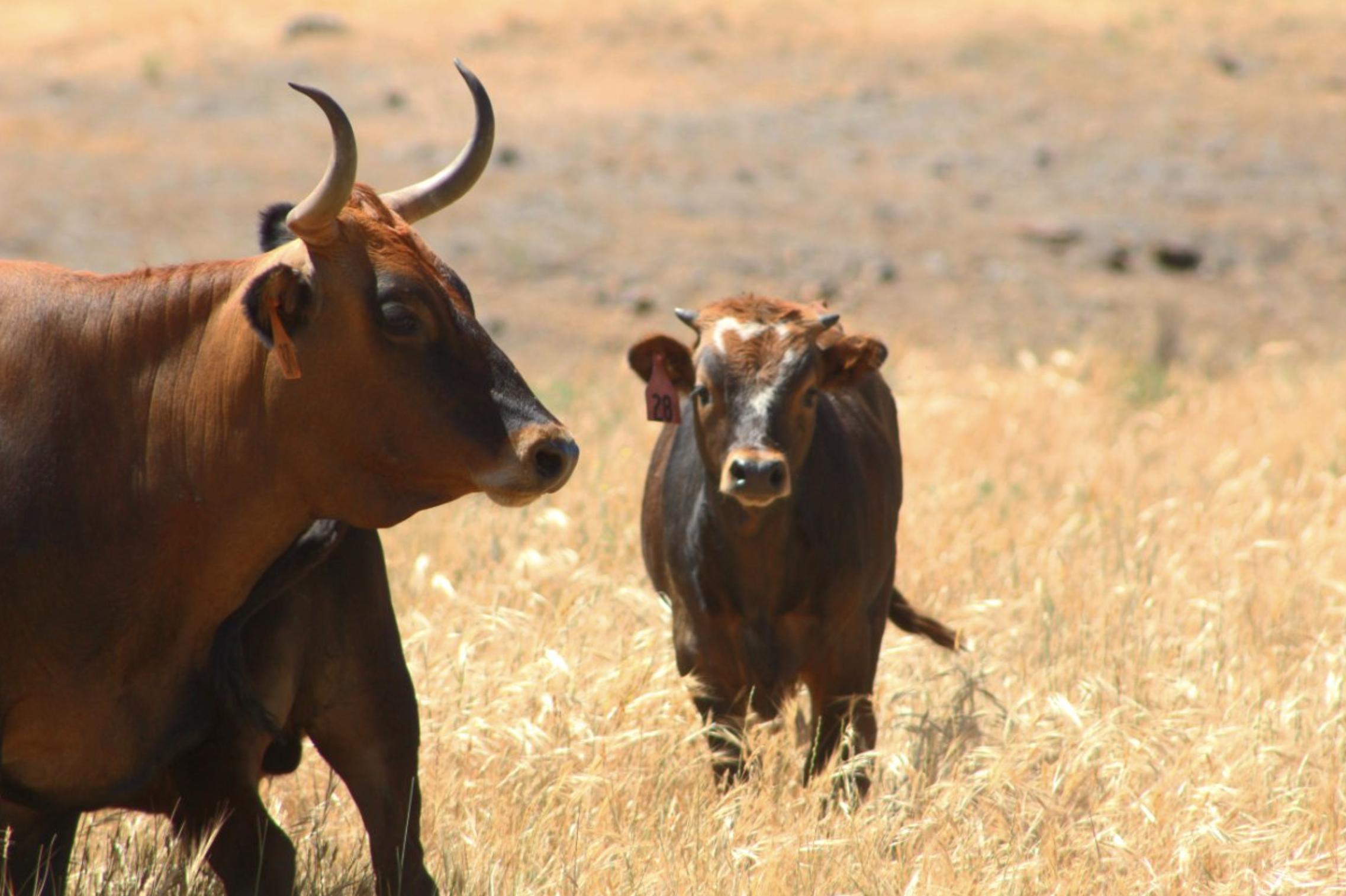Decolonizing Regenerative Cattle Ranching
Decolonizing Regenerative Cattle Ranching
By: Ray Levy Uyeda, Yes! Magazine, September 26, 2022
Photos usable. (1506 words)
When spring hits, Kelsey Scott finally breathes a sigh of relief. Come May, her 120 cows will be ready to birth calves, and as the weather warms, Scott knows the newest members of the herd will be able to grow strong before the arrival of another unforgiving South Dakota winter. While winters test the herd’s resilience, snow on the soil actually protects the soil’s microbes, small critters, and plant root systems that support the cattle’s larger ecosystem. As Scott says, she’s just as interested in the life above ground as she is in the life below it: A healthy soil biome underlies all farming.
Scott is deeply invested in maintaining healthy soil. She is the fourth generation of her family to ranch the land along the Missouri River east of the Cheyenne River Reservation, and the 125th generation of Lakota peoples to steward the land.
Everything on Scott’s ranch, DX Beef, is done a little bit more slowly than one might see on a conventional ranch: Cattle graze rotationally on 14 different permanent pastures across 7,000 acres of land. Because her cows aren’t treated with any antibiotics or chemicals, she and other ranch hands regularly check on the cow dung to make sure it looks healthy; if it doesn’t, cattle are removed from the herd and treated individually.
While some might praise regenerative agriculture as a new advent, the techniques are older than the U.S. itself. These foodways are based on ancient movements now touted under new names: regenerative agriculture, permaculture, farm-to-table, and eating local. But the land theft that built ranching businesses is one of the main reasons Native peoples were killed, disenfranchised, and separated from traditional foodways in the first place.
It’s not lost on Scott that the ranchers getting most of the credit for sustainable techniques are those newest to the land. Native farmers, who have long been pushed to the margins, want newcomers to the world of non-industrial food production to know there’s nothing novel about caring for the land that grows our food.
“It’s not a new discovery,” Scott says. “It’s just a late discovery for some that are a lot more confident in using it as a marketing approach.”
Colonialism via Cattle
Cattle, specifically, can help tell the story of colonization of Native peoples on Turtle Island. Ranching was one of the reasons settlers and colonizers began to claim land from Native peoples west of the Mississippi in the mid-1800s, according to Ryan Fischer, a visiting assistant professor of history at the University of Wisconsin, River Falls, and the author of the book Cattle Colonialism: An Environmental History of the Conquest of California and Hawai‘i.
Fischer says there are no cattle native to this land. Spanish and English colonizers brought them to the U.S. Bison, which are native to the U.S., maintained the Midwest’s rich ecologies and supported the diets and cultural practices of Scott’s Cheyenne ancestors. But bison nearly went extinct because of settlers’ desire to turn Native land into ranchland.
By the mid-1800s, the construction of railways and refrigerated train cars made beef more readily available and affordable. Later, federal officials found that unused fertilizer from WWII munitions could be used to boost corn production, which helped justify the creation of factory farms and introduced beef to an even broader market of consumers.
Around the same time, Scott’s ancestors were removed from their ancestral river with the signing of the Pick-Sloan Missouri Basin Program, which created dams as a means of “flood control.” Scott remembers being told stories of this from her grandparents and great-grandparents; the history of cattle colonialism is still recent.
But thanks to Scott’s work, the land, and the community, is healing.
So while Scott would like to raise bison, these animals need thousands of acres and many years to roam before being ready to slaughter. In today’s agricultural economy, she can’t make a living off them.
“We just can’t do it the way that our ancestors intended for us due to larger systemically oppressive realities that we’re navigating in the development and evolution of what our future food systems are going to look like,” she says.
Cattle, she’s found, are a decent alternative; their hooves roughly resemble those of bison, which means DX Beef cows can help break down soil nutrients. Because she doesn’t use chemicals, the animal waste can naturally fertilize the land in the way bison used to.
After processing, about 90% of the finished beef is sold in the two counties nearest the ranch. The direct-to-consumer business model means Scott is able to offer beef raised on the same land her customers themselves interact with. She’s also been able to address some of the food-access challenges that peoples living on the Cheyenne River Reservation face by bringing healthy options directly to them.
In this way, Scott says her business is “an expression of resiliency amongst a system that disregarded the functioning relationship that we had in agricultural production prior to colonial impact.”
Cross-Cultural Collaboration
Agriculture practices that prioritize soil health and honor an inherent relationship between cattle and the land are increasingly seen as an environmentally sustainable alternative to industrial farming. Raised this way, cattle can create a thriving habitat for soil phytonutrients, support the growth of native grasses, and result in beef that some say is tastier than the industrial alternative.
This system of farming practices, broadly referred to as regenerative agriculture, only accounts for 10% of farms and ranches today, but the numbers are slowly increasing, according to Ryan Siwinski, an organic livestock and dairy consultant for the Rodale Institute, a research and advocacy organization in the organic food movement.
As the movement grows, he says regenerative agriculture is showing consumers, who have long been told that meat consumption is inherently harmful, that the environmental impact has everything to do with the way cattle is raised.
Enrique Salmón, a professor in the department of ethnic studies at Cal State East Bay, is hopeful the larger ranching and farming community will listen to the lessons of Indigenous ranchers and support their leadership in the growing field of regenerative agriculture. He cites a centuries-old system of water management that’s been so integrated in New Mexican culture that many forget it was imported by the Spanish—a story not so dissimilar from that of cattle.
Prior to the arrival of the Spanish, 19 Pueblo tribes relied on a system of water sharing based on irrigation from rivers, streams, and tributaries, but limited transport of water meant Pueblo peoples mainly hunted and gathered their food. This changed after the Spanish introduced the Pueblo tribes to a water-management technique that remains in use today, and acequias, or gravity-fed canals, turned the desert into arable land.
More importantly, acequias increased Pueblo peoples’ ability to farm and grow food without losing their traditional practices. “If those guys could do it, we can figure out other ways for that kind of collaboration to happen,” Salmón says.
Raising Climate Resilience
Western science is now backing Indigenous knowledge that eating locally is best for personal and environmental health. But Spanish and English colonizers brought cattle to the U.S., meaning there are no cattle native to this land.
Still, so-called heritage breeds can be a key tool for climate resiliency, according to Jeannette Beranger, a senior program manager at The Livestock Conservancy, an organization dedicated to raising, sustaining, and saving breeds of livestock whose populations are threatened by industrial agriculture.
Even though many of the breeds supported by the Conservancy aren’t native to the U.S., the genetic diversity they offer can be critical to staving off disease and illness, which industrial agriculture practices are exacerbating with a high usage of antibiotics, pesticides, and other chemicals. With a reliance on breeds of marketable animals, like standard broiler chickens that gain weight quickly, monoculture industrial agriculture threatens to eclipse the cultural and culinary value of other breeds.
Once breeds that are less profitable or more difficult to raise—in other words, breeds that aren’t well-suited for the factory setting—are gone, they’re gone forever.
The Conservancy helps build a community of like-minded ranchers and support a wealth of resources for raising uncommon breeds. But these kinds of organizations and the business platform they offer ranchers aren’t necessarily easily accessed by Native farmers and ranchers.
Scott, for her herd, does not raise “heritage” cattle. Instead, she favors the Black Angus, because she can intentionally incorporate traits from other breeds that create a herd able to endure climate change’s hotter summers and colder winters.
“We have this inherent desire to be connected to the production of our food systems, and we’re going to do that in whatever way that we can,” Scott says.






